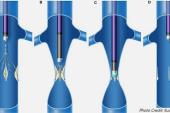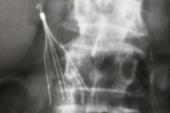Lasers a Valuable Tool to Retrieve Embedded IVC Filters: Multicenter Study
Complication rates were lower than expected, and the excimer laser sheath could remove 95% of the stubborn filters.

Photo Credit: Philips
Excimer laser sheaths can safely and successfully allow chronic indwelling inferior vena cava (IVC) filters to be retrieved, a retrospective study shows. Results were similar no matter whether the procedures were done at a high-volume, experienced center or at less-experienced hospitals.
The newly published data, taken from seven US sites between March 2012 and February 2021, informed the US Food and Drug Administration’s decision to authorize marketing of the Philips CavaClear Laser Sheath late last year. The device “is intended for the removal of tissue to facilitate detachment of an IVC filter during retrieval when previous methods of removal have failed,” an agency press release notes.
Kush R. Desai, MD (Northwestern University, Chicago, IL), lead author of the paper published in JAMA Network Open, said that prior, single-center studies had added valuable information to the evidence base but didn’t speak to generalizability.
“If we’re talking about wider adoption of a technology and a technique, then generalizability is the key missing point,” he told TCTMD. “We already knew that centers were doing it [off-label], but we didn’t have the data to show to the broader medical community, and of course to the FDA, that the application of the excimer laser is safe with a relatively short . . . learning curve for the physician to [know how] to remove embedded IVC filters.”
More than a decade ago, the FDA issued its first safety communication recommending that the filters should be removed as soon as possible once acute pulmonary embolism is no longer a risk, since they can cause complications when left in place. But retrieval is often overlooked and sometimes it’s easier said than done when filters are embedded in the IVC wall—excimer laser sheath-assisted removal aims to meet this need.
Importantly, accumulating data have shown “there isn’t a so-called expiration date for when you can retrieve [IVC filters]. That notion doesn’t apply anymore,” Desai noted. And now, with this analysis, it’s clear that the ability to do these procedures “is not just siloed to one or two centers.”
Centers With Varying Experience
The data set analyzed by Desai et al included 265 patients who underwent laser-assisted IVC filter retrieval. Around half were treated at Northwestern University, a high-volume center, and the rest at the University of Chicago, Oregon Health & Science University, Oklahoma Heart Hospital, the University of Colorado, Saint Francis Healthcare, and the University of Minnesota. Patients were stratified into two groups: the Northwestern University cohort (mean age 53 years; 56% female) and the multicenter cohort (mean age 52 years; 60% female).
The majority of the filters were designed to be “retrievable.” Mean dwell times were 57.1 and 69.7 months, respectively, for the single- and multicenter groups. Half of the Northwestern University patients had had a prior failed retrieval attempt, as did 42.1% of the patients treated elsewhere.
Mean laser activation times were 33.8 and 42.6 seconds in the single- and multicenter groups, while the mean fluoroscopy times were 23.3 and 29.7 minutes.
Rates of device-related major complications (Society of Interventional Radiology classification categories C to F: any adverse event associated with morbidity or disability that increases the level of care, results in hospital admission, or substantially lengthens the hospital stay) were 2.9% and 4.0% in the two groups, respectively (P = 0.74). These fell well within the safety performance goal of 10%.
A total of 66 complications occurred, including nine that were major: two filter fractures with embolization, two IVC injuries, two hematomas, one hemorrhage, a filter penetration, and an IVC perforation. None of the major complications were definitively associated with use of the laser, according to two blinded, independent adjudicators.
Technical success (retrieval of filter body and any fragments deemed retrievable of the lumen based on the clinical judgment of the practitioner) was achieved in 95.7% of the single-center patients and 95.2% of the multicenter patients (P = 0.86), above the performance goal of 89.4%. Reasons behind unsuccessful cases included failure to capture the filter apex, failure to ablate tissue or free the filter from the caval wall, and large acute luminal thrombus.
“What we showed is that there’s very high levels of technical success and safety when it’s applied,” said Desai. Improvements will come not in the form of better outcomes but in “broader application of the technology,” he added, “by recognizing that patients who have devices that are no longer indicated, and are also appropriate procedural candidates, can have the opportunity to have the devices removed potentially with this technology.”
Ongoing prospective registries are now needed “to show that what happens in the real world, now that it’s approved, jibe with what we were seeing in [this] retrospective, multicenter registry,” said Desai.
Caitlin E. Cox is News Editor of TCTMD and Associate Director, Editorial Content at the Cardiovascular Research Foundation. She produces the…
Read Full BioSources
Desai KR, Kaufman J, Truong P, et al. Safety and success rates of excimer laser sheath-assisted retrieval of embedded inferior vena cava filters. JAMA Netw Open. 2022;5(12):e2248159.
Disclosures
- The study was sponsored by Philips.
- Desai reports receiving grants from Philips during the conduct of the study and receiving personal fees from Philips, Medtronic, Cook Medical, Becton Dickinson, Boston Scientific, Asahi Intecc, Tactile Medical, Penumbra, and W.L. Gore outside the submitted work.





Comments